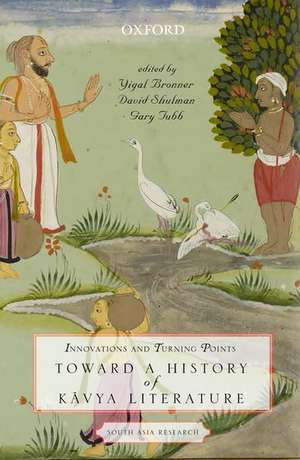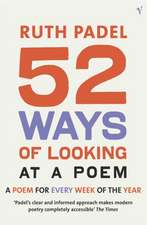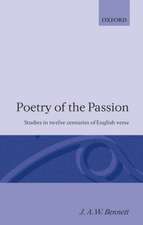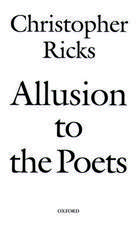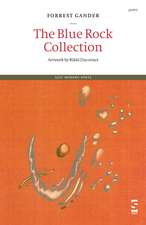Innovations and Turning Points: Toward a History of Kāvya Literature: South Asia Research
Editat de Yigal Bronner, David Shulman, Gary Tubben Limba Engleză Hardback – 8 ian 2015
Din seria South Asia Research
- 30%
 Preț: 3275.75 lei
Preț: 3275.75 lei - 13%
 Preț: 558.34 lei
Preț: 558.34 lei - 22%
 Preț: 498.25 lei
Preț: 498.25 lei - 28%
 Preț: 444.29 lei
Preț: 444.29 lei - 27%
 Preț: 489.76 lei
Preț: 489.76 lei - 30%
 Preț: 879.19 lei
Preț: 879.19 lei - 30%
 Preț: 870.37 lei
Preț: 870.37 lei - 29%
 Preț: 755.59 lei
Preț: 755.59 lei - 33%
 Preț: 938.11 lei
Preț: 938.11 lei - 50%
 Preț: 806.85 lei
Preț: 806.85 lei - 30%
 Preț: 646.43 lei
Preț: 646.43 lei - 30%
 Preț: 678.34 lei
Preț: 678.34 lei - 30%
 Preț: 501.01 lei
Preț: 501.01 lei - 45%
 Preț: 448.13 lei
Preț: 448.13 lei - 48%
 Preț: 414.41 lei
Preț: 414.41 lei - 30%
 Preț: 629.39 lei
Preț: 629.39 lei - 47%
 Preț: 593.97 lei
Preț: 593.97 lei - 30%
 Preț: 987.76 lei
Preț: 987.76 lei - 30%
 Preț: 701.54 lei
Preț: 701.54 lei
Preț: 395.00 lei
Nou
Puncte Express: 593
Preț estimativ în valută:
75.61€ • 82.15$ • 63.55£
75.61€ • 82.15$ • 63.55£
Carte disponibilă
Livrare economică 31 martie-14 aprilie
Preluare comenzi: 021 569.72.76
Specificații
ISBN-13: 9780199453559
ISBN-10: 0199453551
Pagini: 816
Ilustrații: 2 b/w illustrations
Dimensiuni: 167 x 247 x 57 mm
Greutate: 1.26 kg
Editura: OUP INDIA
Colecția OUP India
Seria South Asia Research
Locul publicării:Delhi, India
ISBN-10: 0199453551
Pagini: 816
Ilustrații: 2 b/w illustrations
Dimensiuni: 167 x 247 x 57 mm
Greutate: 1.26 kg
Editura: OUP INDIA
Colecția OUP India
Seria South Asia Research
Locul publicării:Delhi, India
Recenzii
One of the merits of many essays in the volume is that their authors carefully read the works they had chosen for study. This might seem to be an obvious prerequisite, and yet there are histories of...literature that do not fulfill this condition. The book is full of quotations both in the original language and in translation (though one might wish to encounter less mistakes in theSanskrit), accompanied by insightful and minute analyses. Lawrence McCrea's closing paragraph of his essay...contains an important methodological observation, which has been put into practice in some of the best essays in the volume: "It is essential that we attempt to make sense of each poem as a unique object in its own right, which, while it may in some cases be usefully elucidated through terms and categories drawn from either western or indigenous critical traditions, can never simply be uncritically reduced to them" (p. 140).
This collection of essays suggests an ambition to draw kavya literature into the orbit of world literature studies in a sensitive and substantive way. Teachers in the global classroom, one surmises, regularly experience the difficulty of presenting kavya to uninitiated students. This is partly due to the linguistic and cultural gulf that separates any literature from readers outside of that literature's culture. This is a problem for all literary traditions experienced in translation. For kavya, however, the hindrance mostly lies in the sense one gets that the k?vya universe in all its variety has not been adequately translated for the general reader. Also lacking seem to be adequate reading strategies that are both compelling and user-friendly. That complex problem remains even with the publication of this book. Without a doubt, however, this collection is a turning point in kavya scholarship.
the chief delight of this book lies not so much in the range and extent of the area covered, or in the scholarship on display, which is hugely impressive, but in the particular lines quoted or the detailed discussion of a passage that stay in the mind.
This collection of essays suggests an ambition to draw kavya literature into the orbit of world literature studies in a sensitive and substantive way. Teachers in the global classroom, one surmises, regularly experience the difficulty of presenting kavya to uninitiated students. This is partly due to the linguistic and cultural gulf that separates any literature from readers outside of that literature's culture. This is a problem for all literary traditions experienced in translation. For kavya, however, the hindrance mostly lies in the sense one gets that the k?vya universe in all its variety has not been adequately translated for the general reader. Also lacking seem to be adequate reading strategies that are both compelling and user-friendly. That complex problem remains even with the publication of this book. Without a doubt, however, this collection is a turning point in kavya scholarship.
the chief delight of this book lies not so much in the range and extent of the area covered, or in the scholarship on display, which is hugely impressive, but in the particular lines quoted or the detailed discussion of a passage that stay in the mind.
Notă biografică
Yigal Bronner is Associate Professor in the Department of Asian Studies, the Hebrew University of Jerusalem.David Shulman is Renee Lang Professor of Humanistic Studies at the Hebrew University.Gary Tubb is Chair and Professor, Department of South Asian Languages and Civilizations, Division of the Humanities, the University of Chicago.
